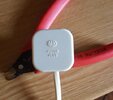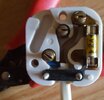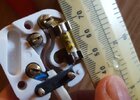But unlikely to fit in a 2A plug and as above too easy to fit a bigger fuse.As below
You are using an out of date browser. It may not display this or other websites correctly.
You should upgrade or use an alternative browser.
You should upgrade or use an alternative browser.
2 Amp round pin plug wired to trailing socket?
And why is everything a negative on this part of the forum …it can be done this way or is everyone a f*ckwick and wil leave a 13 amp fuse in it ?
They are just 2A BS 1362 fuses. I use them extensively, and also 1A ones, but I somehow doubt (haveen't seen) a 2A plug into which they would fit.As below
Kind Regards, John
You would have to ask that of the 'clever clogs' who come up with such ('negative') objections and complications! I merely attempt to pre-empt them!And why is everything a negative on this part of the forum …it can be done this way or is everyone a f*ckwick and wil leave a 13 amp fuse in it ?
Kind Regards, John
The whole point about the negativity (I assume you are including my comments) is standards.And why is everything a negative on this part of the forum …it can be done this way or is everyone af*ckwickF**KWIT and wilL leave a 13 amp fuse in it ?
The whole BS1362/3 idea is a system where the fuse size and its rules did not allow for an overrated fuse, i.e. maximum size of BS1362 fuse is 13A and plugs rated at 13A. See it's quite simple really.
However BS546 also has standards and that didn't include fuses in plugs. There isn't really a problem adding a fuse if such is deemed to be required however the physical dimensions of BS546 plugs is in the standard (Just as true for BS1363) and the size constraints simply does not allow for a BS1363 fuse to fit in a BS546 2A plug.
The plug pictured by Sureitsoff? does not comply with BS546 simply because it exceeds the maximum dimensions in the standard. Added to that it has a BS EN 60127/2 fuse (20x5mm but the standard also covers 1.25x0.25" and possibly more sizes) The maximum rating in the standard is 35A (which would theoretically not blow if used on a UK ring final using 32A MCB) and of course there's a good chance an oversized fuse may be fitted in a BS546 plug.
Only recently I was talking to someone who thought that each physically sized fuse only had one standard rating so he would simply have fitted any BS EN 60127/2 fuse (and probably still will) when the situation arose.
Standards exist for a reason and that includes spelling which sadly isn't one of my strong points either.
Last edited:
It’s not a DIG at anyone …sorry if you think that’s what it read ….I just find the whole electrical section a bit like the two old guys from the muppets ….spinning off into other tangents and going around in circles ….
Fair enough.It’s not a DIG at anyone …sorry if you think that’s what it read ….I just find the whole electrical section a bit like the two old guys from the muppets ….spinning off into other tangents and going around in circles ….
I was being a bit more specific than that, thinking of those (still present or absent!) who, given even half of an excuse, will jump in with (theoretically valid although of little practical relevance) 'negative' comments relating to theoretically possible (but unlikely) future events - like people changing 2/3A fuses to 13A ones, plugging vacuum cleaners into loft sockets installed for wall warts, 'extending' an unfused spur from a ring final etc. etc.
Discussions which 'go off on tangents' (after an initial question have been answered0 are a universal phenomenon in forums such as this, and can sometimes be interesting/useful/'relevant', but which many people may not find interesting (in which case they don't need to read them).
Kind Regards, John
Yes I get that but I also understand your comment assumed it included mine, this doesn't offend me at all in this situation and felt a little explanation was valid.It’s not a DIG at anyone …sorry if you think that’s what it read ….I just find the whole electrical section a bit like the two old guys from the muppets ….spinning off into other tangents and going around in circles ….
One of the problems with the electrical industry is there are regulations and rules but vast swathes of it are... I won't say undocumented but rather left open to interpretation and of course opinion and therefore differing opinions on what is correct and what is incorrect.
Think those fuses might be to BS646 and also used in 13A -> Shaver adapters
I know of a school theatre installation, where 15A plugs were used to suit the dimmer packs, but they were fused and 5A fuses fitted to allow the use of 0.75mm flex and those fuses were to BS646. I've not seen fused 15A plugs anywhere else
I know of a school theatre installation, where 15A plugs were used to suit the dimmer packs, but they were fused and 5A fuses fitted to allow the use of 0.75mm flex and those fuses were to BS646. I've not seen fused 15A plugs anywhere else
Yes I knew they were/are? available and I always believed them to be standard 20x5mm fuses, which as I stated before are available to 35A.2A fused plugs were made by MK. Not sure if they are still available new. The fuse was the same size as in a clock connector and were available up to 5 amp rating.
Also 20 x 5mm glass fuses would fit.
The clock points I used were round and would fit on a besa box, the fuse which I haven't found on google was about the same length, if anything marginally shorter with asymmetric end caps possibly ¼" and 3/16" with no chance of inserting it the wrong way round and only available in 1A.
The other style were older brown bakelite about 1½" diameter and 2 parts with a brass stud through the middle and a round knurled nut to hold the plug in place making it 1½" high, The pins of the plug were the same fuses with the larger end cap trapped between a brass contact and the Bakelite body preventing it coming out of the plug. The socket was a pair of brass springs which the fuses simply pushed against.
They were available with 2 fused pins or one fuse with the second pin being square.
Broadly like this:
There was also a 'break jack' contact option for impulse clock systems, that may possibly have been the version with the square pin.
I don't believe I've ever dealt with the square clock point (MK?) so can't comment on them.
BS646 are ¾" long ~19mm and noticeably shorter and just a little fatter than 5mm.Think those fuses might be to BS646 and also used in 13A -> Shaver adapters
I know of a school theatre installation, where 15A plugs were used to suit the dimmer packs, but they were fused and 5A fuses fitted to allow the use of 0.75mm flex and those fuses were to BS646. I've not seen fused 15A plugs anywhere else
The 5A & 15A fused plugs are more likely to be 20x5mm or 1¼"x¼" to BS EN 60127/2 / BS4265
Sorry for the late reply.
Firstly I am not surprised that despite the official 2A rating of the plug, that the design can likely handle way more current than 2 amps. Would be interesting if someone could put this to the test and see how much current a 2 amp plug can handle before it reaches 70c or what ever temperature is deemed as to high.
Secondly, I meant the question from the perspective of the client wanting an adaptor made to convert the 2 amp plug into a normal trailing socket and how one would react to such a request, sorry I did not make that obvious.
I guess the best thing would be to try and find a single trailing socket that you could fit a 2 amp BS1362 fuse to.
Firstly I am not surprised that despite the official 2A rating of the plug, that the design can likely handle way more current than 2 amps. Would be interesting if someone could put this to the test and see how much current a 2 amp plug can handle before it reaches 70c or what ever temperature is deemed as to high.
Secondly, I meant the question from the perspective of the client wanting an adaptor made to convert the 2 amp plug into a normal trailing socket and how one would react to such a request, sorry I did not make that obvious.
I guess the best thing would be to try and find a single trailing socket that you could fit a 2 amp BS1362 fuse to.
I don’t think such a thing could be coded during an EICR because it‘s not part of the fixed wiring and therefore not covered by the report.
Apart from that I whole-heartedly agree with what was said before, a 2-amp plug and socket could likely take up to 10 amps unless the terminals were extraordinarily flimsy. The pins are shorter but thicker than the 4 mm pins of French 6-amp and Italian 10-amp plugs.
Apart from that I whole-heartedly agree with what was said before, a 2-amp plug and socket could likely take up to 10 amps unless the terminals were extraordinarily flimsy. The pins are shorter but thicker than the 4 mm pins of French 6-amp and Italian 10-amp plugs.
I can't speak for the socket, but, without doing the experiment, as for the pins of the plug, I think they have a CSA of about 10mm² - so I would guess that, in terms of the pins, it would probably take something like 60A or so to raise its temp to 70 °C.Firstly I am not surprised that despite the official 2A rating of the plug, that the design can likely handle way more current than 2 amps. Would be interesting if someone could put this to the test and see how much current a 2 amp plug can handle before it reaches 70c or what ever temperature is deemed as to high.
I think yopu were actually clear enough, even if none of us responded particularly directly to your question! I did, in post #5, write "... It obviously does not feel very right ... ", but I then did go on to say (much in keeping with the above comments) "..... but I wouldn't personally be all that concerned. If you look at the pins of a 2A plug (and the corresponding bits of the socket), then, despite the 'rating', I'm far from convinced that they would be any less able to carry 13A than a BS1363 plug /socket."Secondly, I meant the question from the perspective of the client wanting an adaptor made to convert the 2 amp plug into a normal trailing socket and how one would react to such a request, sorry I did not make that obvious.
That would be 'nicer' (although I'm not sure that such animals exist), but there would still be those 'clever clogs' who would be concerned that someone might change thge 2A fuse for a 13A oneI guess the best thing would be to try and find a single trailing socket that you could fit a 2 amp BS1362 fuse to.
Kind Regards, John
DIYnot Local
Staff member
If you need to find a tradesperson to get your job done, please try our local search below, or if you are doing it yourself you can find suppliers local to you.
Select the supplier or trade you require, enter your location to begin your search.
Please select a service and enter a location to continue...
Are you a trade or supplier? You can create your listing free at DIYnot Local




